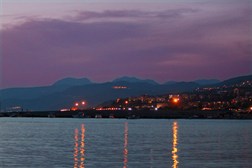Paola
Calabria participated, with great enthusiasm, in the winds of revolution which engulfed the Neapolitan viceroyalty in 1647-48. Energised by the news from the capital, the protest extended to both major centres and smaller ones like Stilo, Seminara and Paola. The urban popular clases, peasants, but also vast proportions of the middle classes protested with force against the oppressive fiscal pressure and the excessive power of the feudatories. During the year 1648, the revolt was progressively quelled and the Duke of Monteleone was sent to Calabria by the viceroy, the Count of Oñate, to snuff out the last pockets of resistance. The power of the barons remained solid in the territory, in spite of the progressive indebtedness of the great familes which were often obliged to dismember their patrimony and the progressive transfer (already in place some decades before) of many Calabrian noblemen to Naples with the enormous costs which the lifestyle of the life of the capital supposed. The arrival of the rule of the Austrian Habsburgs (1707) and the occupation of the Neapolitan throne by the Bourbons (1734) did not bring any substantial changes to the socio-political situation in the region. Even in the eighteenth century Calabria was struck by a series of natural calamities: in particular the plague of of 1743-1744, the famine of 1763-1764 and the earthquake of 1783. In the second half of the eighteenth century there was a definite decline of the silk industry which, in the previous centuries, had been the true motor of the economy of many zones of Calabria. Olive growing extended throughout the greater part of the territory which had been used to grow mulberries, which have leaves that are consumed by silkworms.
 From the fifteenth century onwards the city of Paola became recognised as a flourishing centre for the production of raw silk and as an important commercial port in the Tyrrenean sea. An important economic and administrative centre in the feudal domains of the Spinelli, the city became famous especially due to the fame of its patron saint Francis of PaolaFrancis of Paola (1416-1507) was a religious from the Calabrian city, a hermit, the founder of the Order of Minims. He died in Tours and was proclaimed a saint by Leo X only 12 years after his death (1519). The patron of the Kingdom of the Two Sicilies and co-patron of the city of Naples, he is venerated above all in his place of origin. A part of his relics are conserved in Paola, at the sanctuary which bears his name., whose cult was a cause of devotion for many faithful already in the early modern period. The sanctuary of Saint Francis, of Renaissance origin, presents many noteworthy Baroque elements, above all in the chapel which holds the relics of the saint. In addition, the fountains of the Sette vie (Seven ways) and of the Pisciarieddi, the churches of the Rosario with the adjoining Jesuit college and of Montevergine, the Torre dell’orologio and the Valitutti palace all date from the Baroque period.
From the fifteenth century onwards the city of Paola became recognised as a flourishing centre for the production of raw silk and as an important commercial port in the Tyrrenean sea. An important economic and administrative centre in the feudal domains of the Spinelli, the city became famous especially due to the fame of its patron saint Francis of PaolaFrancis of Paola (1416-1507) was a religious from the Calabrian city, a hermit, the founder of the Order of Minims. He died in Tours and was proclaimed a saint by Leo X only 12 years after his death (1519). The patron of the Kingdom of the Two Sicilies and co-patron of the city of Naples, he is venerated above all in his place of origin. A part of his relics are conserved in Paola, at the sanctuary which bears his name., whose cult was a cause of devotion for many faithful already in the early modern period. The sanctuary of Saint Francis, of Renaissance origin, presents many noteworthy Baroque elements, above all in the chapel which holds the relics of the saint. In addition, the fountains of the Sette vie (Seven ways) and of the Pisciarieddi, the churches of the Rosario with the adjoining Jesuit college and of Montevergine, the Torre dell’orologio and the Valitutti palace all date from the Baroque period.
